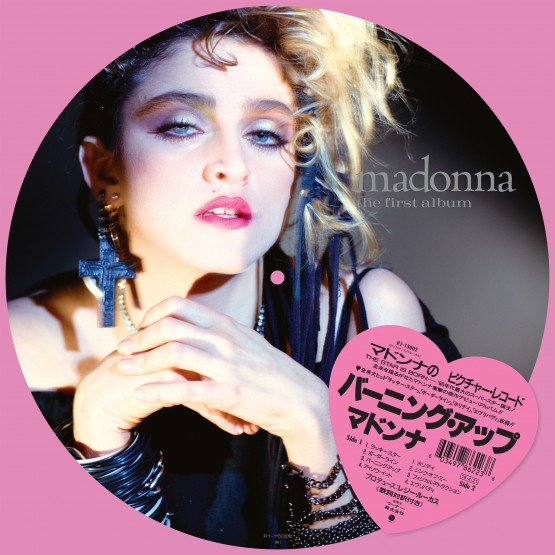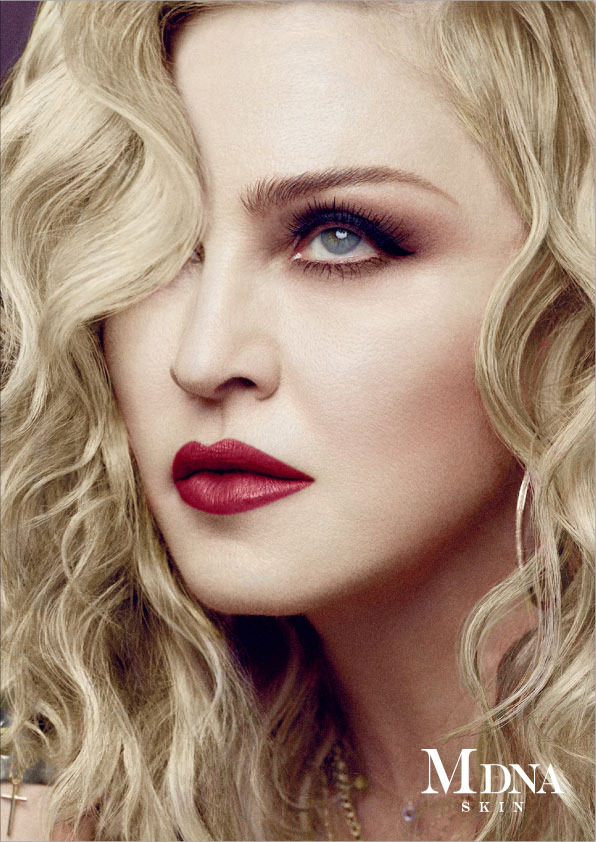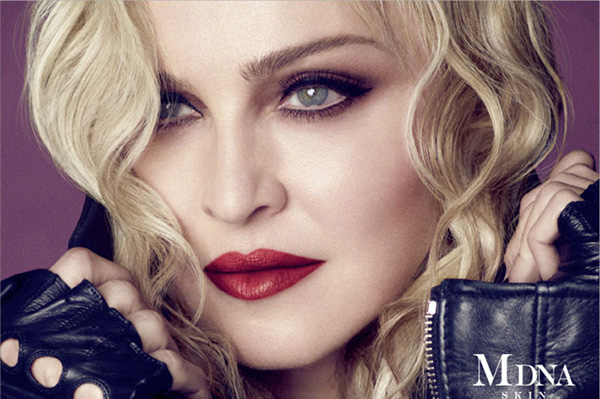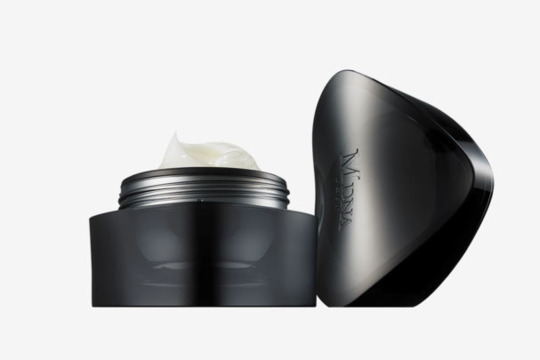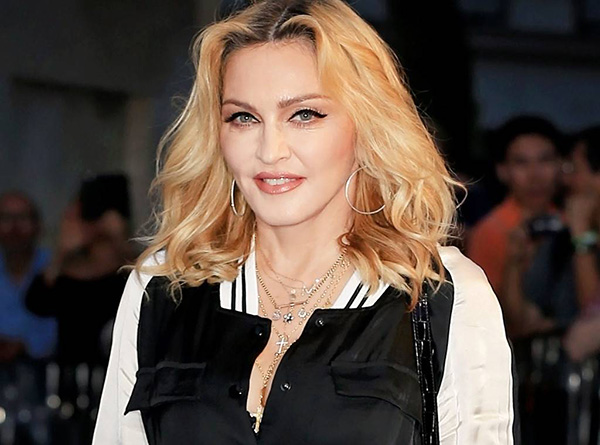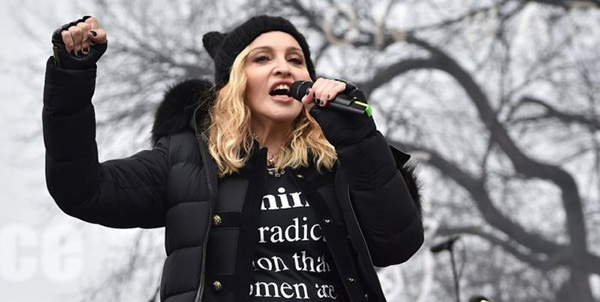| |
Madonna news - April 2018
← March 2018 | May 2018 →
Marvin Gofin discusses dancing on Madonna's tours
Source: Usquare - 30 April 2018French dancer Marvin Gofin played a major role on the MDNA Tour and Rebel Heart Tour. For Usquare, he discusses the auditioning process, the gruelling rehearsals and... the risks of giving honest feedback to M ;-)
Madonna's 'American Life': Revisiting the divisive album 15 years later
Source: Billboard - 22 April 2018While American Life certainly wasn't the kiss of death for Madonna, her ninth studio album did end one of the winningest streaks in the history of pop. Although the LP — which was released 15 years ago on April 21, 2003 — did debut at No. 1 on the Billboard 200 chart, it became the lowest-selling studio LP of her career up to that point. And the reviews were mixed at best.
The title-track lead single was one of Madonna's first bona-fide flops, certainly by her standards. It barely cracked the top 40 on the Billboard Hot 100, peaking at No. 37. Even worse, it was the object of derision for her stiff, silly rap in the second half where she rhymes "latte" with "shoté" and "MINI Cooper" with "super-duper" and "trooper." No one wants to hear Madonna rap about her lawyer, manager, agent, chef, nannies, assistant, driver, jet, trainer, butler, bodyguards, gardener and stylist. Not then, and not now. The failure of "American Life" made it hard for the album to recover with subsequent singles "Hollywood," "Nothing Fails" and "Love Profusion" missing the Hot 100.
But revisiting American Life 15 years later, it deserves more love than it has gotten -- it's perhaps the most underappreciated album of Madonna's catalog. Listening to it now, it certainly bests Rebel Heart and MDNA, and from a lyrical standpoint, it probably beats 2008's Hard Candy and maybe even 2005's beloved Confessions on a Dance Floor. In fact, with its confessional tone and commentary on the American Dream in the President George W. Bush era, American Life is easily one of Madonna's better lyrical outings.
The strong lyrical perspective is complemented by the cohesive musical vision. Madonna worked with one producer, French electronic savant Mirwais Ahmadzaï, for the entire album—although there was additional production by Mark "Spike" Spent on "I'm So Stupid" and "Nothing Fails"—and they expanded on the folktronica experimentation they did on 2000's Music. Indeed, if there is one Music song that served as the biggest touchstone for American Life, it's "Don't Tell Me," with its twangy trip-hop. Madonna and Mirwais—who are back in the studio working on new music together in 2018—also co-wrote all but three of 11 songs together. With such a tight team, not one of the songs feels out of place (although the dramatic "Die Another Day" from the James Bond film of the same name feels like it should have been sequenced earlier in the record).
In retrospect, American Life — the last truly ambitious album that Madonna has made — also marked the end of a very important phase of her career. Having achieved new artistic depth with 1998's Ray of Light and continued that creative spirit with Music, she was very much still in risk-taking mode on American Life. You might say those three albums — starting from an electronica base but veering in different directions — amounted to her Berlin Trilogy. On an aesthetic level, this period was Madonna at her Bowie-est.
"Love Profusion," "Nobody Knows Me" and "Nothing Fails" make for a thrilling three-song sequence that displays varied moods and styles. While glowing with its sweet strumminess, "Love Profusion" faces some troubling uncertainties: "There are too many questions/There is not one solution/There is no resurrection/There is so much confusion." The zig-zagging "Nobody Knows Me" packs a rock thump and a sense of disillusionment: "This world is not so kind/People trap your mind/It's so hard to find/Someone to admire." And "Nothing Fails" — the glorious, gospel-infused centerpiece of American Life — is nothing short of a latter-day "Like a Prayer."
Elsewhere, "X-Static Process" — co-written by Stuart Price, who Madonna would go on to work with for much of Confessions on a Dance Floor — is a beautiful ballad rich in harmony and emotional directness. You can almost hear echoes of R.E.M. on that and the previous track, "Intervention." Meanwhile, the solemn, string-laden "Easy Ride" may be one of the best album closers of Madonna's career. The lyric nods to her notorious work ethic: "I want the good life/But I don't want an easy ride/What I want is to work for it/Feel the blood and sweat on my fingertips/That's what I want for me."
American Life — which still sounds very modern and, in some ways, seems eerily prescient of Trump-era despair — feels more like the Madonna album for now than her recent efforts. It's not a perfect album — "I'm So Stupid" is still irritating — but it's the sound of Madonna challenging herself, and us.
Record Store Day 2018 includes two Madonna releases
Source: NME - 21 April 2018The full list of releases for Record Store Day 2018 has been announced. It includes two releases for Madonna:
Madonna – 'The First Album' (1 x ???g 12″ picture disc w/ obi strip)
Madonna – 'You Can Dance' (1 x 140g 12″ Red translucent vinyl 7 track EP)
Madonna joins other stars in mourning for Avicii
Source: Instagram - 21 April 2018As the music world reacts shocked to the news of the sudden death of Swedish DJ Avicii, Madonna has joined other artists to express her condolences. Posting a picture of the 2012 Ultra Music Festival, when Madonna joined Avicii's set on stage, she commented:
So Sad....... So Tragic. Good Bye Dear Sweet Tim. 💙 Gone too Soon. #avicii
Madonna and Avicii worked together in 2014, when he co-produced several tracks for the Rebel Heart album, including Devil Pray, HeartBreakCity, and the title track Rebel Heart.
As #mirwais hashtag continues, the collaboration gets likelier
Source: Instagram - 20 April 2018Since Wednesday, Madonna has used the hashtag #mirwais twice more, making it now very likely that she is in fact working with Mirwais in the recording studio.
In the post below, she has also used the promising hashtags #magic, #compose, #creation, and #inspiration.
Now it's waiting for the first preview of actual music!
And even more videos added on Youtube
Source: Youtube - 20 April 2018More Madonna videos keep being added to Madonna's official Youtube channel. Today's additions so far include Gambler (1985), Who's That Girl (1987), Veras (1995), Don't Cry For Me Argentina (1996), and Die Another Day (2002).
5 classic videos added on Madonna's official Youtube channel
Source: Youtube - 19 April 2018Madonna's team continues to add videos that were so far missing from her official Youtube channel. Today the following videos were uploaded: Burning Up (1983), This Used To Be My Playground (1992), I'll Remember (1994), You Must Love Me (1996), and Beautiful Stranger (1999).
Share them to get those views up quickly!
'American Life' turns 15 | An anniversary retrospective
Source: Albumism - 18 April 2018Happy 15th Anniversary to Madonna's ninth studio album American Life, originally released April 21, 2003.
For close to a decade dating back to 1994's Bedtime Stories, Madonna gracefully held the music world in the palm of her hand. With two subsequent albums and an accomplished soundtrack to an even more accomplished film (1996's Evita), Madonna had taken back the creative power misplaced with Erotica (1992). That record sought controversy over content as its lure and failed to find followers.
The anticipation for what Madonna would do next was palpable and "Die Another Day" was more than an adequate appetizer for what was to come. Unveiled in the fall of 2002, the kinetic single was both the theme song to the James Bond film of the same name and the unofficial first offering from her then untitled ninth studio album upon which it would also feature.
As winter gave way to spring, Madonna was now preparing to unleash American Life and its titular track as the set's "official" debut single. The accompanying music video, directed by Jonas Åkerlund, was fitted with all the trimmings of a controversy—a rarity for Madonna during this stretch of time when the focus was on her craft, not a random firestarter.
It was with that in mind that she unexpectedly pulled the plug on the original video—later subject to reshoots—and then issued the following statement on April 1st, 2003 in lieu of the burgeoning Iraq War:
"I have decided not to release my new video. It was filmed before the war started and I do not believe it is appropriate to air it at this time. Due to the volatile state of the world and out of sensitivity and respect to the armed forces, who I support and pray for, I do not want to risk offending anyone who might misinterpret the meaning of this video."
Public perception toward Madonna's statement—or apology—was mixed. It was a glaring portent promising that American Life was to meet stormy waters on its April 21st, 2003 reveal date. But despite any of the difficulties that were to come for it, the record's roots were firmly planted in only the richest artistic soil, the same soil that had nurtured its preceding effort Music (2000).
Music had been eagerly tended to by Madonna and the French producer/instrumentalist Mirwais Ahmadzaï. Theirs was an enthusiastic and imaginative relationship, one with an exacting eye for detail and precision and this same work ethic carried over into the very early stages of the American Life sessions in late 2001. As the long player's form began to take shape, it received embellishments and contributions from fellow songwriters, producers and musicians such as Mark "Spike" Stent, Guy Sigsworth, Jem Griffiths, Monte Pittman and Stuart Price. However, it was Madonna and Ahmadzaï that kept the overall record on track to become what is was to be—an edgy, eclectic confessional tome.
Topically, everything is on the table here—Madonna's second marriage ("Love Profusion," "Nothing Fails"), her relationship with her parents ("Mother and Father"), her place in the modern world ("American Life," "I'm So Stupid"). Nothing was off limits. All of these lyrical battle studies regarding love, family, and self-discovery are intelligent, feeling and, sometimes, brutally candid.
Musically, Madonna delves further into her own niche experimentation with electronic and guitar-flecked pop that came to life on Music, the latter genre giving way to a folk base on American Life. The genres are suited to each other, managing to function independently ("Nobody Knows Me") and collectively ("Love Profusion"). Could a few of these songs be labeled "danceable?" Certainly they could, but, Madonna didn't restrict them to that genre box alone. In fact, their surrounding production minutiae—samples, loops, live strings and acoustic guitar—suggested an emphasis for long term listening versus momentary consumption on any dance floor. And, in a classic Ciccone chess move going all the way back to "Crazy For You," the ballad method is utilized stunningly to showcase Madonna as a top tier vocalist in her own right, as evidenced by "Intervention," "Nothing Fails," "X-Static Process," and "Easy Ride."
As a body of work, American Life presents itself as the product of a woman with a sense of artistic clarity and wisdom. Its only equal in Madonna's canon is Ray of Light (1998).
Upon its late April 2003 unveiling, the LP immediately polarized critics and fans. Either they praised or panned it, there was little to no middle ground. Its sales were devastatingly slow. Taking into account "Die Another Day," American Life produced six singles in all, four commercial, two promotional—almost all of the positive traction they gained happened abroad, with "Die Another Day" as the lone domestic exception.
The rejection of American Life signaled the end of an era for Madonna, as she has yet to challenge herself, or her audience, as audaciously as she did on this collection. Yet, American Lifehas aged beautifully, the abundance of its vision to make Madonna's private challenges and triumphs into open-air personal politics that listeners could see themselves in was intimate and eloquent. It is, without question, the last album where Madonna pushed the envelope where it mattered—musically.
Is Madonna reuniting with Mirwais?
Source: Instagram - 18 April 2018Back in the recording studio, Madonna has posted an Instagram video singing along to some song. While she comments "No This is NOT my new music. But im having fun in the studio in between takes!!", it's the hashtag #mirwais that has both fans and the press buzzing.
While some are automatically assuming this means the French producer is in the studio with Madonna to record material for the new album, others are more sceptical because it could just mean that she's singing to one of Mirwais' existing songs.
Madonna and Mirwais Ahmadzaï first worked together in 1999 on the song Paradise (Not For Me) for Mirwais' album Production. A few months later, it would become one of 6 Mirwais-produced tracks on Madonna's 8th studio album Music. In 2003, Mirwais was the main producer of the American Life album. Their most recent collaboration dates back from 2005 for the songs Future Lovers and Let It Will Be.
Will a new chapter be written in the Madonna-Mirwais collaboration book? We'll have to wait for further clues!
Madonna on butt masks and how to fight ageism
Source: The Cut - 15 April 2018Madonna calls at 9 a.m. from Portugal. The singer and mother with just a first name is on the phone to talk about her newest project: skin care. She's obsessed with it like everyone else, and launched her own line, MDNA Skin, this year. The Cut talked to Madonna about having glowy butt skin, her newest product (MDNA's Reinvention Cream), and how she responds to ageist critics and detractors.
Okay, so I read that you do a mask on your butt. Is that true or was that a joke?
I take the clay mask and put it everywhere. Just for fun, I tried it as an experiment. I put it on my décolletage, my breasts, and my arms. Then I put it on my butt. I work out a lot and if you do mat work, you're always sitting so you can get dry patches.
I thought, Let me try this here. It was really good! It had the same effect. You just have to be willing to lay on your stomach and not move, while naked. And then [my facialist, Tarin] Skillets comes and removes it — such a fun job she has.
A butt mask might be the only beauty product not yet invented.
It's kind of a no-brainer. You can take any face mask and try it on your behind. Skin is skin. I think people would want the skin on their butt to be smooth, glowing, and hydrated. I mean, I know I do. There are certain special people that get to see our butt and you want it to look its finest.
You're synonymous with reinvention. And it sounds almost too good to be true, but your new cream contains something called the resurrection plant.
It is kind of a perfect circle of connection with DNA, love, heart, and soul all put into a skin-care line. Before working on this, I had never heard of the plant. MTG [the company behind MDNA] brought it to my attention. It's all over Africa. I spend so much time there that to me, it was poetic and perfect that I would be able to incorporate a plant that I'm around all the time but never pay attention to, inside of this cream.
I also love the words resurrection and reinvention. Then there's the other R word, resilience. I love that. To live with very little moisture,then you give it to the plant, and it reinvents itself. I like to think that I do the same. I feel connected to [the plant] for its ability to maintain and keep going against all odds.
What do you remember from the first time you visited Malawi?
I remember seeing so many people suffering. There were so many children left alone, abandoned and orphaned by AIDS. I remember their vulnerability, and watching so many of their parents and extended family dying and to not be able to do anything about it was heartbreaking.
At the same time, I was also struck by the happiness and joy they managed to connect to. Despite suffering so much loss and having so little, they were still were joyful people who could smile and be grateful for the tiniest things. That was a great lesson. I thought I was going there to help them, but they were actually helping me to recognize gratitude.
It was really important with this product to make sure a portion goes into helping Africa, especially in the area of education. After primary school, it's not encouraged for girls to go to school. All the work that I do goes back into either education for girls, health care, pediatrics, or building schools.
You've been vocal about saying we need to fight ageism. How do we do it?
We need role models. People are afraid of things they don't know and that are unfamiliar. Women have a different place in the world now. We're finding more work and fighting for more gender equality in the workplace. As we do that, we should keep working on not only our career but on ourselves. It's about staying curious, staying alive, and working on making ourselves feel good whether it's through exercise,skin care, etc. There are no rules.
It's an outdated, patriarchal idea that a woman has to stop being fun, curious, adventurous, beautiful, or sexy past the age of 40. It's ridiculous. Why should only men be allowed to be adventurous, sexual, curious, and get to have all the fun until the day they leave this earth? Why should that only be the domain of men? How do we fight this? By standing up to men and by standing up to social mores or standards that say we cannot. The more women that do it, it will just be a matter of time.
In the beginning of my career, I got so much flak for using sexuality as part of my creativity and was called a sexual provocateur. Now, all the challenges that I had to face 20 years ago seem ludicrous. What I am going through now is ageism, with people putting me down or giving me a hard time because I date younger men or do things that are considered to be only the domain of younger women. I mean, who made those rules? Who says? I'm going to keep fighting it. Ten to 20 years from now, it's going to be normal. People are going to shut up.
When people talk about getting older, particularly when it comes to women, they use words like "battling" or "fighting" or doing it "gracefully." How would you describe your approach?
I don't think about an approach to aging. I just think about my approach to life. I don't do anything different than I used to do. I keep going. I continue being creative and working. I write, travel the world, am adventurous, curious, learn, and I seek knowledge. I listen to my children, I pay attention to them, and I see the world through their eyes. All those things keep you youthful.
Some people go, Okay I don't want to work anymore. They pack up their bags and move to some secluded villa in the mountains. I get that's a life for some people, but not for me. Of course, you have to take care of yourself. You have to eat right, practice good nutrition, exercise, and all the obvious things everybody knows. I never smoked. I don't go in the sun. I've always taken care of myself.
I never think I am fighting age. I'm just continuing on with my life as I always have. I've never gotten complacent. I've never gotten comfortable. I keep pushing myself into uncomfortable positions and taken risks. I moved to Lisbon with my four children. I could have stayed in NYC with my comfortable life, but I didn't. If you keep putting yourself in challenging, new adventurous situations, then you keep yourself alive and youthful.
Reverb.com analyses the synth sounds of Into The Groove
Source: Reverb.com - 15 April 2018Welcome back to "The Synth Sounds Of…", our ongoing series where we dive into the beats and sonic textures of some of the biggest pop hits of all time. Last week, we leapt into the juicy Oberheim goodness of Van Halen's "Jump", and today we're turning to the work of fellow '80s iconoclast Madonna.
While there are many worthwhile, synth-laden Madonna hits that we could've chosen from this era, 1984's "Into the Groove" from the Like a Virgin LP is the only one that directly deals with the lyrical subject of getting into a groove, which is our exact prerogative with these videos.
As our resident synth tone slinger William Kurk explains in the video above, the baseline of this track was originally recorded on a Roland MKS-80 Super Jupiter rack unit triggered via a sequencer. Here, we're using a Minimoog Model D, which Madonna's live band used at the time, to achieve a similar tone. The synth chords on the record seem to have come from a Juno-106, but in the video we went with a Juno-6 to better illustrate how things are coming together.
The original drum track on "Into the Groove" was produced by an Oberheim DMX, which ranks alongside the Roland TR-808 as one of the key drum machines of the decade. Also like the original 808, a vintage DMX comes with a pretty sizable price tag these days. You can find samples of these analog sounds in the Reverb Oberheim DMX Sample Pack or the Goldbaby Custom DMX software emulation.
Check out our Soundcloud track below to hear our take on "Into the Groove," where we use an Arturia Mini V3, Prophet V, and Jup-8 to nail these classic pop tones. (Find details of a Reverb Exclusive Arturia Sale below.)
Donatella Versace: "Madonna was there to comfort me after Gianni's murder"
Source: W Magazine - 10 April 2018Twenty years removed from her brother's tragic death, Donatella Versace is more comfortable in her own skin than she's ever been and seems sick of others trying to tell both her story and the story of her family. Especially because when they do, they often get it wrong, according to Donatella, at least.
Following the 20th anniversary of Gianni Versace's murder, this past July, a new batch of documentary specials, news stories, and, most notably, Ryan Murphy's American Crime Story: The Assassination of Gianni Versace have purported to give audiences the inside story of what happened. Versace, meanwhile, has been on her own tear of candid interviews; in her latest, which also touches on her struggles with addiction, her love life, and succession plans, she drops a stunning detail about the days following Gianni's murder that none of the books, documentaries, or fictional takes have included before: Madonna was there.
"After identification, I drove to Gianni's villa on Ocean Drive. Madonna was waiting for me inside," Versace tells fashion journalists Michael Ebert and Sven Michaelsen in a new no-holds-barred interview with Ssense. "I will never forget that she was trying to comfort me during these hours. There were FBI agents everywhere in the house. They interrogated each of us and opened all the drawers, a nightmare. My brother had just been murdered, and we were being treated like suspects. But that's probably what FBI agents have to do."
Of course, American Crime Story did show its take on the exact moments Versace describes. They were pivotal scenes, and, obviously, Madonna wasn't anywhere to be found in their telling. Had Ryan Murphy known that the Queen of Pop was there, he surely would have figured out a way to include her in the narrative (after all, he managed to controversially shoehorn the Kardashian sisters into the anthology series' first season, about O.J. Simpson, even though the then-young sisters were only tangentially related).
The reason for Madge's presence? Somewhat amazingly, this wasn't widely known by the public before, though it had been hinted at. On the day of the murder, Donatella was in Rome preparing for an upcoming fashion show. Madonna was in a recording studio, presumably in Los Angeles, working on her album Ray of Light. During interviews about the making of the album, producer William Orbit revealed that indeed Madonna was one of the first people Donatella called, on the very same day she recorded the vocals for the album track "Swim."
"We were recording 'Swim' on the day Versace was murdered," Orbit told Q magazine in 2002. "Madonna was very friendly with him and his sister, Donatella, who was in the street, distraught, on her cell phone to Madonna. But she did the vocal, which is probably why it has such an emotional impact."
The Huffington Post e-mailed Orbit earlier this year for elaboration on the story, and while Orbit declined an interview he did write, in an e-mail, "There's quite a story around that."
Quite a story, indeed.
At the time, Madonna had an expansive house on the Miami mainland, and was a frequent guest at the Versace mansion. It would not have been a stretch to imagine her stopping work on the album upon getting news of a close friend's death and flying to Miami. But how would she have gotten into the home without anyone knowing until now? One of the things the show did get correct is that it was a media circus outside of Casa Casuarina following the murder. Yet the scene in which Donatella Versace walks into the house through the front doors at the main steps was complete fiction: The home had far more private entrances in the back. It's likely Madonna was able to sneak in, and if someone had found out then, we all would have known about it by now. If they hadn't, well, we would only know when someone inside the actual house told us, which appears to be the case now.
Madonna releases Re-Invention Cream commercial, feat. The Fat Jewish
Source: Instagram - 9 April 2018Madonna has released a new Instagram video, which serves as commercial for her new Re-Invention Cream, part of the MDNA Skin line. It shows M and her new bestie The Fat Jewish judging a dance audition set to the tones of Erotica.
A few days earlier Madonna posted a video in which she explained the Re-Invention Cream to Kim Kardashian.
Madonna: "I want to keep finding new music to make and new ways to present my music"
Source: E Online - 9 April 2018You don't have to be a music icon to get great skin. But being Madonna helps.
Even at a young age, the "Like a Virgin" singer has always been diligent about maintaining a healthy complexion. When she didn't have much money, she used to get facials from a heroin addict, Madonna shared at the U.S. launch of her beauty brand, MDNA Skin, in September 2017. Now the 59-year-old queen of pop has the resources and platform to share her devotion to skin care with the masses.
"The biggest challenge is getting the story out there—where does this line come from and why it is important to me, that it's not a vanity project, why I developed it in the first place and connecting to people on a human level," said Madonna to E! News in a phone interview.
You could just scoop up her latest launch—a four-in-one (toning serum, lotion, cream and mask) product appropriately titled, The Reinvention Cream ($75). Like all MDNA products, the lightweight jelly-cream features M.T.Parca Thermal Water, which comes from four different springs in Montecatini, Italy, known for its healing properties. The cream also features three African Resurrection plants (the ones that can sustain extreme dehydration then spring back alive with water). But as Madonna can attest, basic lifestyle choices—the ones that cost almost nothing—can improve your skin, too.
Here, the Material Girl reveals the skin-care tips she imparts on her kids, three beauty products she always has in her bag (hint: one is crazy affordable!) and more!
E! News: It's been three or four years since you first launched in Japan. What are you most proud of?
Madonna: The ingredients are important to me—the fact that they are made with all-natural ingredients, that the hero ingredient of the line is thermal water that comes from Tuscany and that have been a part of healing people for thousands of years. I feel like there's history to it; there's authenticity to it. It's not just talk; it's also walk. It's great when you're not wearing makeup; it's great when you are wearing makeup. My 17-year-old [Rocco Ritchie] son uses it. It's something that everybody loves, and I'm very proud of that.
Since your son uses your products, do you also give him or any of your other children beauty tips?
Hell yes! Are you kidding? First of all, I'm like, "Don't squeeze your pimples! Please. You're scarring your face." Also, a lot of people think that if they dry their skin out all the time, they aren't going to get acne. You can get acne from having your skin too dehydrated. My son is always coming into my bathroom and stealing all of my skin-care products. It's very funny to have a 17-year-old son saying, 'Mom, can I have more serum? I need some more face wash. I need some more of this.' I think it's hilarious. My 21-year-old daughter [Lourdes Leon] loves them. I feel like I'm getting nods of approval from people from all walks of life, and it's not just female either. It's male as well—that means a lot to me. And, of course, I do advise my children on a regular basis: "Don't smoke. Stay out of the sun. Why are you drinking that? Stop picking at yourself."
What about those who can't quite afford luxury beauty products?
I was broke until I was 25-26 years old. I couldn't afford fancy skin care but I could take care of myself. I didn't go to the beach and get a sun tan. I never smoked. I didn't really drink that much. I have nice skin because I paid attention to those things when I was younger. Now, hopefully, with this Reinvention Cream, which is at a much lower price point than the rest of my line, kids without money or people without a lot of money will be able to afford this all-in-one moisturizer. I'm going to continue creating a line with a lower point as well for people who can't afford the line that is presently out right now. I have so many ideas that I don't want to share yet. It's going to be great.
What's your nighttime routine look like?
Washing my face, rose mist spray and then serum if I'm not feeling too dry. If am I feeling dry or if I'm in a cold place and there's a lot of heat, then I use the Reinvention Cream. Or if I'm wearing makeup during the day, I will also use the Finishing Cream. It's all about hydration. You can't do enough.
What are three things that are always in your bag?
I don't go anywhere without The Rose Mist spray in my bag. I wear it on the plane, during my workout. I have this weird theory that it gives me energy, and I love the smell of rose. And my serum is always with me, and besides from that, I love PawPaw cream ($10)—it comes in a red tube. I use it on my lips. It's the best.
Since the product is called The Reinvention Cream—how will you reinvent yourself next?
Skin care is not the only thing I do. I'm an artist, first and foremost. Well, no, I'm a mother first and foremost. Making sure my children have received the guidance they require in this crazy world that we live in and that they turn out to be decent, loving and compassionate human beings is my number one goal. After that, I want to keep finding new music to make and new ways to present my music, whether that's live performance or film slash video. Keep pushing the envelope artistically and creatively.
Once I establish the skin care line and it's doing well and I've created a base for myself and a certain level of success, then I'd like to slowly make my way into the [makeup] world but keep it simple. I don't want to have a huge line. I'm not a makeup artist—I wish I was. I can't do my own makeup—it's really tragic.
Do you have any beauty regrets?
People always ask me that question. The thing is I've gone to so many events, got my picture taken so many times, that I don't even remember. No regrets. It's too ephemeral to have a regret.
Spoken like the Mother of Reinvention.
Madonna donates $2 mil to charity, including $1.3 mil to African children's hospital, $250K to Kabbalah Center
Source: Showbiz411 - 1 April 2018Madonna is still giving big chunks of money to the controversial Kabbalah Center in Los Angeles. In 2016 she donated $250,000 to the cult that has taken millions from her over the last 20 or 30 years.
According to the new Form 990 for Madonna's Ray of Light Foundation, that was about 1/10th of the total money Madonna made in charitable grants. Altogether she gave away $2 million– way up from previous years.
More than half the total– $1.3 million– went to Raising Malawi, her other foundation. That money went to the building of a children's hospital in Malawi, Africa– the first time Madonna's years of traveling to Madonna and adopting children there has actually produced a tangible effect. So that's good news.
She also gave $250,000 to Creating Hope International in Dearborn, Michigan. Their mission is to "assist local organizations that work at the grass roots level in Afghanistan and India, helping people improve their lives and communities."
Ray of Light also gave a measly $5,000 to Madonna's pal Rosie O'Donnell's important foundation for kids learning theater, and $10,000 to cancer research at the TJ Martell Foundation. She also sent $10,000 to the Community Foundation in Flint, Michigan, which still doesn't have clean water. As usual, even though her biggest following is in the gay community, Madonna gave zip to AIDS research, etc, nothing to Elton John's AIDS Foundation or amFAR.
But the $1.3 million for the children's hospital in Malawi is a big deal, especially after past projects fell through or the money disappeared. So kudos for that.
↑ Back to top of page
